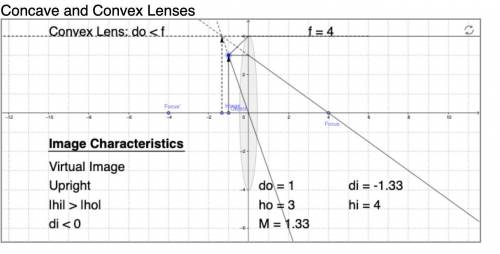
Physics, 21.06.2020 00:57 esmemaluma00
Now we will use these three rays to construct a ray diagram in order to locate an image as you see in the simulation. For that on a separate sheet of paper draw the optical axis and the lens plane. Use your value of the focal length to mark the left and right side focal points and label them each “F.” Now draw an arrow with its base at the optical axis which has a height, h, of 2.0 cm and is located 9.0 cm from the center of the lens (9.0 cm will be the object distance, s). This arrow represents the object.



Answers: 1


Another question on Physics

Physics, 21.06.2019 23:00
Athermometer is removed from a room where the temperature is 70° f and is taken outside, where the air temperature is 10° f. after one-half minute the thermometer reads 60° f. what is the reading of the thermometer at t = 1 min? (round your answer to two decimal places.) ° f how long will it take for the thermometer to reach 30° f? (round your answer to two decimal places.)
Answers: 3

Physics, 22.06.2019 00:20
Consider the particle-in-a-box problem in 1d. a particle with mass m is confined to move freely between two hard walls situated at x = 0 and x = l. the potential energy function is given as (a) describe the boundary conditions that must be satisfied by the wavefunctions ψ(x) (such as energy eigenfunctions). (b) solve the schr¨odinger’s equation and by using the boundary conditions of part (a) find all energy eigenfunctions, ψn(x), and the corresponding energies, en. (c) what are the allowed values of the quantum number n above? how did you decide on that? (d) what is the de broglie wavelength for the ground state? (e) sketch a plot of the lowest 3 levels’ wavefunctions (ψn(x) vs x). don’t forget to mark the positions of the walls on the graphs. (f) in a transition between the energy levels above, which transition produces the longest wavelength λ for the emitted photon? what is the corresponding wavele
Answers: 1

Physics, 22.06.2019 01:10
Aparticle initially moving east with a speed of 20.0 m/s, experiences an acceleration of 3.95 m/s, north for a time of 8.00 s. what was the speed of the particle after this acceleration, in units of m/s? give the answer as a positive number.
Answers: 1

Physics, 22.06.2019 05:00
Aperson standing in a canoe exerts a force of 700 n to throw an anchor over the side. find the acceleration of the canoe if the total mass of the canoe and the person is 100 kg?
Answers: 1
You know the right answer?
Now we will use these three rays to construct a ray diagram in order to locate an image as you see i...
Questions





Mathematics, 01.01.2020 14:31




History, 01.01.2020 14:31



Social Studies, 01.01.2020 14:31


Biology, 01.01.2020 14:31

Biology, 01.01.2020 14:31

History, 01.01.2020 14:31

Mathematics, 01.01.2020 14:31

History, 01.01.2020 14:31




